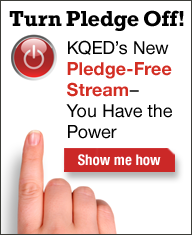I am a monthly donor to my local public radio station so that I don’t even have call in during its pledge drives — they’ve already got my donation. So despite their attempts to make the morning drive pledge pitches compelling, by the second or third day I turn the station off in the morning because I’m sick of pledge drive. I know it’s a necessary evil, and I’ve been just as responsible working in community and college radio. So I do empathize with the listeners who pledged early to the stations I’ve worked at, too. Nevertheless, when I’m just the listener who has already donated, I just want to go back to regular programming.
San Francisco’s KQED has come up with a remedy for its early donors — a pledge-drive free webstream. This feed is only for folks who have ponied up $45 or more, and it is only online. While the station had been toying with the idea for a while, it is only with the growing popularity of mobile devices that can stream online radio that it seemed feasible.
I think KQED is smart to publicize this option well in advance of the actual drive, which begins May 5. This way they’re giving a lot of incentive for would-be donors to get their pledges in early. They’re also garnering a fair degree of publicity for their drive, which otherwise wouldn’t be newsworthy at all. Getting in a significant number of pledges in advance of the start date may also help the station reach its goal faster, cutting the drive short.
However, like all good marketing techniques, it will be interesting to see if this one has legs, and if other stations also take up the mantle. Putting up a pledge-free stream does require producing a whole other stream of programming, which may be too expensive and complex for smaller stations. And as the idea loses its novelty the incentive may wear off for many listeners who will go back to needing to be reminded dozens of times on air before they finally make their pledge.
The station also potentially risks losing multiple donations from a single donor who is moved a second or third time by a new pitch or special premium gift. I don’t imagine that these donors who give multiple times make up more than a small percentage of overall donors. But having worked and coordinated many pledge drives in the last fourteen years, I do know that these donors do exist and their overall contributions really do add up.
I predict that KQED’s pledge-free stream experiment will be successful in helping the station hit or break its goal ahead of schedule. The novelty and publicity will help see to that. Then I expect that other public stations in larger markets with the resources to pull of a second live stream of programming will jump in and see some gains, too. But I’m not entirely sure that we’ll see the idea still going four years from now. Or, we may see the idea get diluted, with the pledge-free stream turning into the fewer-pledge-breaks stream.
I am very interested to see how this plays out.



